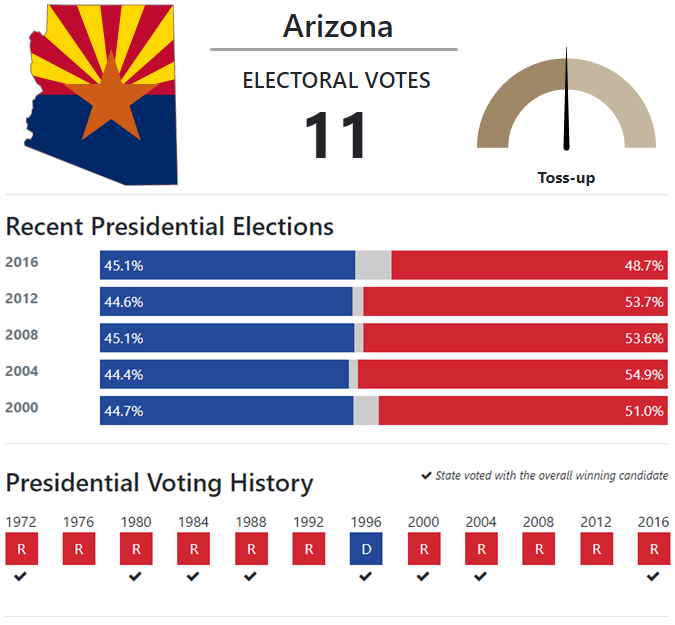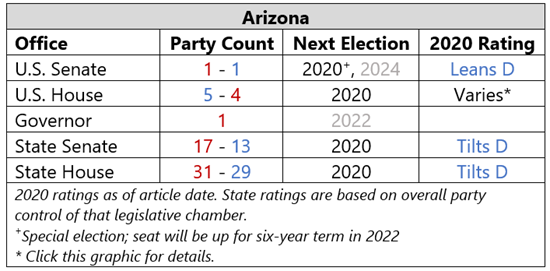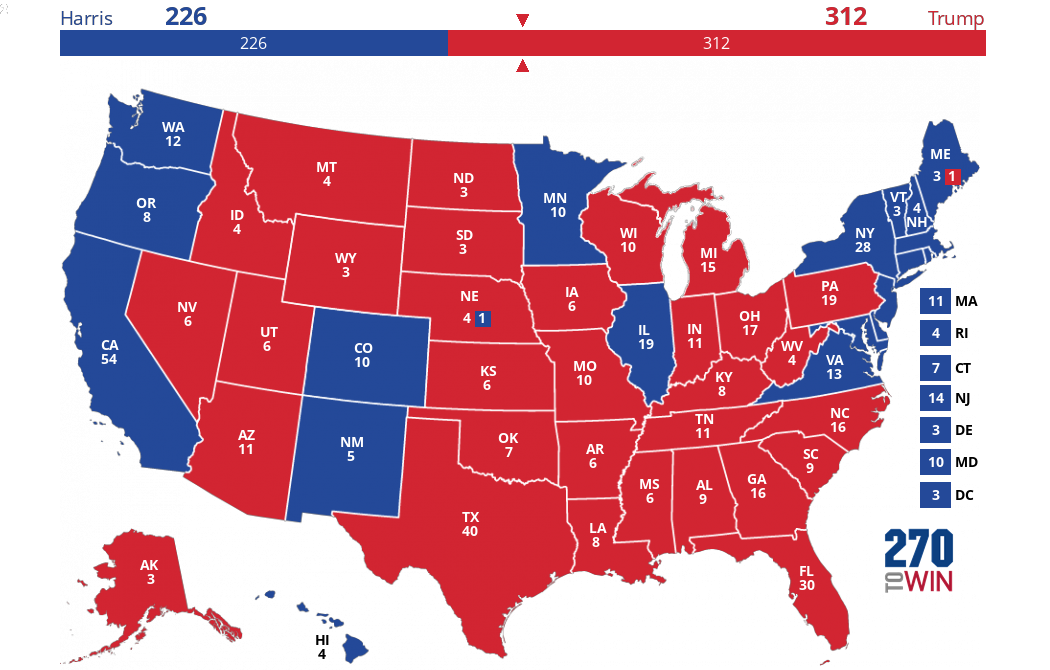The Road to 270: Arizona
By Drew Savicki
October 5, 2020
The Road to 270 is a weekly column leading up to the presidential election. Each installment is dedicated to understanding one state’s political landscape and how that might influence which party will win its electoral votes in 2020. We’ll do these roughly in order of expected competitiveness, moving toward the most intensely contested battlegrounds as election day nears.
The Road to 270 will be published every Monday. The column is written by Drew Savicki, a 270toWin elections and politics contributor. Contact Drew via email or on Twitter @DrewSav.
Buoyed by a shift among college educated whites and a growing Hispanic population, the Grand Canyon State finds itself at the center of attention this year. The fast growing suburbs of Phoenix have not just attracted retirees but young professionals as well. 2018 put Arizona Democrats back on the map: they won a U.S Senate contest there for the first time in 30 years, flipped three other statewide offices, one U.S. House seat, and a multitude of seats in both chambers of the legislature. With millions of dollars being spent on ads dominating the airwaves, Arizonans are learning for the first time what it's like to live in a swing state.
Crucial Maricopa
Usually, Arizona elections are won and lost in Maricopa County. Home to 60% of the state's population, Maricopa is a sprawling county home to almost four million people. Since 2010, just one candidate has won statewide while losing Maricopa County. It is is the largest county in the nation that voted for Donald Trump in 2016. What makes it interesting is not just its size in terms of population but also its size in terms of area -- by land area, it’s larger than four states. As one of the nation's largest suburban counties, Maricopa has traditionally been Republican but there are signs the party's dominance is coming to an end.
In 2016, controversial Sheriff Joe Arpaio (R) lost reelection to former Phoenix police sergeant Paul Penzone (D). An outspoken opponent of illegal immigration, Arpaio was the state's most controversial figure over the years. His office had repeatedly been accused of police misconduct, he used police resources to "investigate" then-President Obama's birth certificate, engaged in racial profiling, and erected what was called a "tent city" at the county jail. In office, Penzone has worked to restore public confidence in the Sheriff's office and has spent of much his term undoing his predecessor's decades long legacy. Arpaio attempted a comeback this year but lost in the primary to his former deputy. It seems unlikely Penzone is in much trouble but could have faced a tough race had Republicans nominated someone not connected to Arpaio.
Aside from the sheriff’s race, Democrats won the contest for County Recorder in 2016. Recorder Adrian Fontes handles elections -- though his office faced some criticism in 2018, Fontes won praise for overseeing a smooth primary election this year.
Congressional politics
Perhaps none define the spirit of Arizona more than the Grand Canyon's state's two most legendary Senators: Barry Goldwater and John McCain. Goldwater, the party's 1964 nominee for President, kickstarted the modern conservative movement, although his brand of libertarian conservatism has long since fallen out of favor with the party. A critic of the growing influence of the religious right in the GOP, Goldwater by the end of his career saw his star fade and was eclipsed by more mainline conservatives like Ronald Reagan. In addition, Goldwater's stance on abortion rights made him increasingly an outlier in a party that was becoming more and more defined by social conservatism. His support for gay rights and medical marijuana put him at odds with social conservatives, who vehemently opposed both. Goldwater got to the Senate after defeating Majority Leader Ernest McFarland (D) in 1952, and in 1964 gave up that seat to run for president. But he came back in 1968 to win the state’s other Senate seat. He retired in 1986, paving the way for then-Rep. John McCain to ascend to the Senate.
A Captain in the U.S. Navy who served his country honorably in Vietnam and became a prisoner of war, John McCain first ran for office in 1982, at the urging of his friend - Delaware Senator Joe Biden. McCain and Biden met a few years prior when McCain served as the U.S. Navy's liaison to the Senate and that experience working with Senators influenced his decision to run for Congress. McCain represented Arizona's 1st District in southeastern Maricopa for two terms before running for the Senate in 1986. During his time in the Senate, McCain was known as a moderate conservative. Although generally a reliable vote for his party, McCain did sometimes break with his party and his willingness to criticize his party earned him a reputation as a 'maverick'. One of McCain’s signature achievements was the McCain-Feingold act, which regulated campaign finance. Another later achievement of his was the Veterans Choice Act, which President Trump has repeatedly taken credit for, even though it became law before he ran for President.
Known for his ‘straight talk,’ McCain ran for President twice, first in 2000 and then again in 2008. McCain's 2000 campaign is still fondly remembered as one of the most media accessible campaigns. McCain was quite popular with reporters but among the GOP faithful he fell flat. In a pre-9/11 world, his focus on defense issues just simply did not resonate with voters. One of the more noteworthy events of the 2000 campaign was a push poll ahead of the South Carolina primary that made a racist insinuation about his adopted daughter.
McCain long struggled with his right flank and that was again a problem for him in 2008. Still, McCain easily carried his some state that year and although he weighed retiring, ultimately ran for reelection in 2010. McCain's final election was 2016 where he faced his closest race from Ann Kirkpatrick (D), then the representative of the state's first district. During his last few years in the Senate, McCain had a fractious relationship with Donald Trump. McCain made no secret of his distaste for the President’s disruptive political style and Trump made no secret of his dislike of the legendary senator. In a moment that would define his career, John McCain voted down his party’s attempt at repealing the Affordable Care Act (Obamacare) in the summer of 2017. McCain -- a traditionalist, was frustrated by the unusual and rushed process in which the repeal was considered.
Elected in 2018, Arizona’s senior Senator - is Democrat Kyrsten Sinema. The first Democrat elected to the Senate from Arizona since 1988, Sinema is one of two openly LGBT members of the Senate and the only religiously unaffiliated member of the body. A moderate Democrat, Sinema is known for her bipartisanship and often polls as the state’s most popular politician. In the Senate she has made a concerted effort to win the support of people who did not vote for her. Sinema has a long history in Arizona politics. She was first elected to the state legislature in 2004 as a progressive Democrat. Before she ran for office, she was a Green Party activist and even volunteered for the Nader campaign in 2000. In 2012, Sinema ran for the newly created 9th Congressional District, which was anchored in southeast Phoenix and its suburbs. Originally drawn as a swing district, Sinema quickly locked down the district and her margins grew with each passing cycle.
McCain's death, in 2018, came too late for a special election to be held that year. Gov. Doug Ducey appointed former Sen. Jon Kyl to the seat. Kyl had previously been a colleague of McCain's, serving alongside him from 1995 to 2013. Kyl served in a caretaker role, resigning at the end of 2018. Ducey then appointed Rep. Martha McSally, who had just lost the other Senate race to Sinema.
McSally is now trying to win a 2020 special election to complete the final two years of McCain's term. As an Air Force veteran, she has an impressive story, but has struggled in polls. In the House, McSally was known as a moderate Republican but she tacked sharply to the right when she ran for the Senate. Since her appointment, she has been a reliable supporter of the President’s agenda. She is facing a strong challenge from former astronaut and Navy veteran Mark Kelly. The husband of former Rep. Gabby Giffords, who used to represent Arizona’s 2nd District, Kelly is one of the Democratic Party’s strongest first-time Senate candidates this year. Kelly has outraised McSally in every fundraising quarter and led her in all public polls this year. Both Sabato’s Crystal Ball and the Cook Political Report rate the race as ‘Leans Democratic,’ and it’s not out of the question that Kelly could win even if Trump carries the state again. Sinema recently weighed into the race -- she endorsed Kelly and blasted McSally.
Although the state has seen considerable action this year at the Presidential and Senate levels, there has been comparatively little attention to paid to the state’s House seats. The Crystal Ball and Cook list two and three districts as competitive, respectively. Let’s take a look at those seats.
Encompassing Flagstaff, the Navajo Nation, and Casa Grande, the 1st District is roughly the size of Georgia. This sprawling northern Arizona district was drawn to be a fair-fight district but Democrats have held it since 2012, as Republicans have fielded a number of poor candidates over the years. A racially diverse and polarized district, it is currently represented by Democrat Tom O’Halleran. A retired police officer and former Republican, O’Halleran ranks among the most moderate Democrats in the House. He was won two terms by about 7-8 percentage points both times. This district has a strong liberal base in Flagstaff but a strong conservative base in places like ancestrally Democratic Greenlee County.
_2.jpg)
This district leans slightly right of center in presidential elections but the growth in Flagstaff and the impact of COVID on the Navajo Nation suggests it could vote for Joe Biden. Democrats are spending minor amounts here to shore up O’Halleran but Republicans don’t seem terribly interested. Forecasters disagree on how to rate this district. Both the Crystal Ball and Inside Elections rate it as ‘Likely Democratic’ but Cook has it at ‘Leans Democratic.’ O’Halleran faced a surprisingly close primary challenge this year from former Flagstaff City Councilor Eva Putzova. O’Halleran struggled in Flagstaff but dominated in the more rural parts of his district, especially so in the Navajo Nation. He has made Native outreach a priority during his time in office and it paid off in spots.
Nestled in the southeastern corner of Arizona, AZ-2 is home to much of Tucson and its suburbs. After she lost her bid for the Senate against McCain in 2016, Ann Kirkpatrick moved to Tucson and ran for the open 2nd District -- it being vacated by Rep. Martha McSally, who was running for the open Senate seat. McSally was generally popular in this district, as she easily won reelection in 2016 while Hillary Clinton carried the district. Kirkpatrick won the open seat by almost 10 points in 2018. In the Senate race that year, McSally lost it by 7% to Sinema. The Crystal Ball still rates this as ‘Likely Democratic’ but Cook has it as ‘Solid Democratic.’
The most educated district in the state is AZ-6 -- it is entirely within Maricopa County and includes Scottsdale, Paradise Valley, and part of Phoenix. It was once a Republican bastion but there are signs that’s changing. Rep. Dave Schweikert (R) has been stung by a long-simmering ethics probe into his campaign finance practices and the suburban revolt against President Trump has pushed this district into the ‘Toss-up’ category. After spending a considerable amount on legal fees, Schweikert’s campaign account is nearly empty. Democrats have an ideal candidate in Dr. Hiral Tipirneni, who has considerably outraised Schweikert. Tipirneni unsuccessfully ran for the neighboring 8th District in the 2018 special election and then again in the regular November election. Given her competitive performance in that redder district, she seems like a strong candidate. This is a district to watch, not just at the House but at the presidential and Senate levels too.
State level politics
2018 saw a breakthrough for Democrats at the state level. The party picked up three state executive offices. Although Democrats largely ignored the gubernatorial race, those wins give them a solid bench for 2022. This year, Arizonans will be voting again on recreational marijuana in a referendum. A similar measure failed to pass in 2016 -- it looked on track to pass this year, but more recent polling suggests the result could be close.
Though he was easily reelected in 2018, Gov. Doug Ducey has seen his approval ratings fall as his state dealt with a large COVID-19 outbreak. Although the state is long past its peak, Ducey’s approval ratings have not risen. He is often mentioned as a potential 2022 candidate against Mark Kelly, should he win. However, given Ducey’s underwater approval ratings, his political future seems less clear.
Democrats are seeking to flip both chambers of the legislature this year and as of right now, they are slight favorites in both. Democrats need to pick up two just seats in the House and three in the Senate in order to win control.
Arizona is set to gain another congressional district following the Census. Unlike many other states, Arizona uses a bipartisan commission with an independent tiebreaker. In the 2001 redistricting, the commission emphasized protecting incumbents and in 2011, the commission emphasized drawing competitive districts. It seems likely that the redistricting process next year will use both criteria to some extent.
Presidential politics
Arizona last voted Democratic for President in 1996 but it is one of Joe Biden’s top pickup opportunities in the nation. So how could the home of Barry Goldwater become a swing state? Well first let’s look at its history. Arizona was settled first settled by prospectors in search of gold and the Mormons led by Brigham Young, as they ventured out west. As a heavily industrial state, Arizona was reliably Democratic from statehood until the rise of suburbia in the 1950s. The advancements in air conditioning technology and the creation of age-restricted communities brought flocks of older Republican voters from the East Coast. The Grand Canyon state would vote Republican for President from 1952-1992.
By 1996, President Clinton was enjoying a rise in popularity and the economy was booming. A member of the Baby Boomer generation himself, President Clinton had something of a kinship with those voters, and Arizona had many of them.
Arizona reverted Republican in 2000, and has remained there since. But bolstered by a changing electorate and Trump’s unpopularity among suburban voters, Hillary Clinton lost the state by just 3.5%. Although Joe Biden is lagging slightly behind Clinton with Hispanic voters, his strength with older voters and college educated whites bodes well for him in Arizona. All is not lost for Trump, though -- Arizona does have a rather large non-college educated population, including one demographic that has been reliably Democratic in the state, Native Americans.
Perhaps Biden's greatest asset in the state is his endorsement from John McCain's widow, Cindy. President Trump, for his part lashed out at her endorsement, a decision that is unlikely to help him with the suburban women whose votes he needs. Senator McSally responded very differently, though McCain has said she will sit out the Senate race.
Compared to previous Republican nominees, Trump has made great gains with non-college educated voters across racial lines. Particularly worrisome for Arizona Democrats is Apache County. Though solidly Democratic and 75% Native American, it has very low levels of college attainment and those voters are essential part of the Democratic coalition in the state. Mobilizing the Native vote is a key priority for the Biden campaign to put the state in their column on November 3.
Next Week: Florida
Remaining Schedule: Iowa (10/19), Georgia (10/26), North Carolina (11/2). Dates subject to change.
We use the model powering the 2020 presidential election simulator to determine the following week's state. Specifically, we will look at the 'Battleground 270' results of 25,000 simulations run late Sunday afternoon. Of the states remaining, the next to be covered will be that with the highest likelihood of a Trump or Biden win as of that date. View the current state-by-state probabilities in the table at the bottom of the Battleground 270 page.
Reports in this series:



